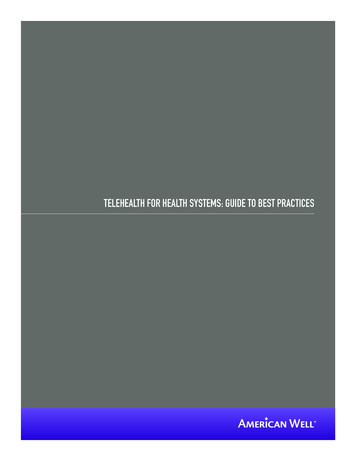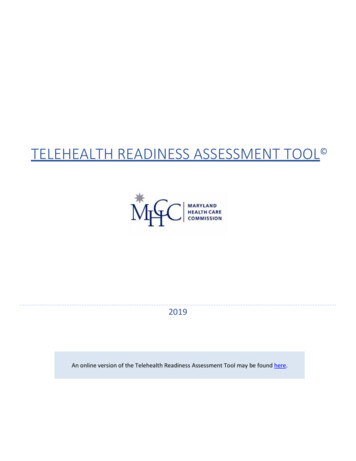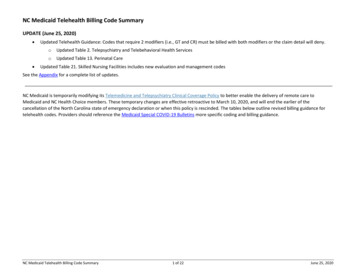
Transcription
TELEHEALTH FOR HEALTH SYSTEMS: GUIDE TO BEST PRACTICES
OverviewTelemedicine delivers care that’s convenient and cost effective – letting physicians and patients avoid unnecessary travel and waittime. Health systems that offer telehealth see increased referrals, higher patient satisfaction ratings, and better care co-ordination– especially when they offer access to limited specialty care. When used for post-surgical applications, telehealth promises to helplower readmissions. And for health systems that have accepted payment based on an Accountable Care contracts, telehealth is a wayto ensure that patients stay within your system for all their care.Historically, deploying telemedicine meant huge investments for health systems. Expensive custom hardware, costly pilot studies, andtravel to pre-approved locations for patients and doctors were the norm. Today? Not so.With innovations in technology and increased patient sophistication, telemedicine – increasingly referred to as telehealth – no longerrequires costly and difficult investments. Now health systems can implement telehealth entirely with software by using smartphones,tablets, and virtually any web-enabled computer.Advances such as built-in cameras, better sound, and higher bandwidth networks are making it easier than ever to connect withpatients – not just in special clinical locations – but in their homes and offices. This window into patients’ home environments givesclinicians valuable insight that can lead to better care. Without the historical downsides, savvy health systems are now looking toimplement next-generation, consumer-friendly telehealth.Figure 1: Applications of Telehealth in Health SystemsDoctor-Prescribed Telehealth:In this model, doctors and their support staff will use telehealth as a way to better care for existingpatients from their brick-and-mortar practices. At American Well, we have seen applications ofdoctor-prescribed telehealth across a spectrum of clinical areas, including: cardiology/heartfailure, dermatology, diabetes, hospice, neurology pediatrics, post-surgical home care, psychiatry,and oncology. Such programs typically have outcome-related objectives such as handling patientconcerns, medication titration, and follow-up care without travel or delay; bringing specialty careto a broader geography within a referral network; avoiding re-admissions; and improving patientsatisfaction.Online Urgent Care:These “web walk-ins” help patients deal with minor acute, episodic conditions, much like in anurgent care setting. The value to health systems is that they keep patients in the system ratherthan seeking care elsewhere from exernal, disjointed settings. And the mobile app puts yourbrand right in the patient’s pocket, so when they do have more extensive care needs, they canrely on their on-going relationship with your system.Employer Sales:Increasingly, health systems are selling telehealth services directly to employers as a way toprovide immediate access to care, typically in concert with narrow networks and PCMH/ACOservices. Such arrangements can work well for health systems (and generate substantial savingsfor contracted employers) by concentrating care. Telehealth kiosks are a key part of the equationfor employers – rapidly replacing costly on-site clinics that typically rely on separate staff andcan serve only the largest offices. Kiosks serve a real need to keep work force onsite rather thantravelling to clinics.1
Getting StartedPlanning for an effective telehealth implementation starts with making the right decisionsabout people and workflow, selecting a system that’s easy to activate and ready to scale,and planning a communications program that will bring physicians and staff as well asFigure 2: What Patients Wantpatients to table. To get started, your organization needs: An effective partner; The right internal team; Collaborative planning.In this eBook, you’ll learn how to select the right partner, assemble the right internal teamand develop an implementation plan for a seamless telehealth launch.Part One: Pick the Right PartnerThere are a wide variety of telehealth services on the market, representing all thingsfrom high-cost, high-tech telepresence systems, all the way to low-tech/limited-value“healthcare roulette” telephone call-back models. It’s critical to know what you’re gettingDoctor choicebefore you make the investment.Ease of useThere are a few key elements any product you choose should have. The most criticalAffordableare what we like to call the 5 C’s: consumer-friendly, clinically-integrated, customizable,compliant with regulations, and robust clinical operations. Here’s how you can identify allfive in a possible partner.Figure 3: What Physicians Want1. Consumer-friendly: With patient-centricity driving reforms across healthcare, healthsystems need to start thinking like retailers. That means making it as easy as possiblefor patients to get the right care at the right time. From mobile apps to minimal waittime, make sure your partner has a high “net recommender score” (the percentage ofpeople who would recommend the service to friends and family). Retailers considerthis score the gold standard in customer satisfaction, so take a page from their bookand make sure your telehealth partner has stellar satisfaction ratings.Elements that consumers look for in a positive telehealth experience includea choice of doctors available; transparent physician profiles including a photo,list of professional interests, where they went to school, and affiliations; patientchoice of device – especially support for video visits on mobile devices; integratede-prescribing; easy record keeping; support for dependents; and the ability to see thesame doctor again, not always be handed off to the “next available”.We always recommend that executives involved in a telehealth selection process tryHigh patient satisfactiona visit as a patient – not a pre-planned “demo,” which can always be made to lookClinical integrationgood – but a bona fide, no warning, show-up-and-use-the-system experience thatSecurity and compliancewill sort out players that deliver from those that have good Powerpoint presentations.2
2. Clinically-integrated: Doctors conducting a telehealthOthers envision new types of practices – such as an onlinevisit need information about the patients they see, and datadiabetes practice combining endocrinologists, eye doctors,generated from a telehealth visit needs to end up back in yourpodiatrists, fitness coaches, and diabetes educators.system of record. At a minimum, the telehealth system should4. Compliant: The telehealth regulatory landscape is evolvingcapture information that can easily be exported to any EMR torapidly. As recently as 2011, there where only a handful ofmaintain the ongoing patient record.states that had permissible medical board guidelines andThe best systems will also import data to a visit through real-legislation that allowed any form of telehealth to take place.time web services that require little ongoing oversight from yourThat has evolved favorably in the years since, but each state(already taxed) IT resources. But since deep EMR integrationsis different. Any vendor that promises uniform applicationcan take time, look for a vendor that can do a phasedacross all 50 states either doesn’t understand the complexitiesapproach, with import/export capabilities in CCR, CCD, andinvolved or is simply willing to gamble against the state medicalcustom formats.boards. Make sure you pick a partner who won’t put your3. Customizable: In order to attract and retain patients (anddrive patient lifetime value), your telehealth service needs toreflect your health system’s brand and unique care expertise.doctors’ licensure and professional reputation at stake just toclose a sale.5. Clinical Network Operations: While building and staffingIn addition to basic branding principles like using your healthan online medical practice is similar to managing a brick-system’s logo, look for a partner that enables your ownand-mortar practice, there are additional complexities andphysicians to serve patients via the telehealth system. Makeintricacies. Health systems should look for a telehealth partnersure your partner can help you as needed with coveringwith expertise and experience creating and managing aservices for “lights on” 24/7 physician availability – withscalable workforce of providers, managing supply/demandappropriate reporting back to your in-house physicians.and schedule adherence, and forecasting patient volume andBe sure your telehealth partner can support not only mobileand web access, but also kiosks – which are gaining popularityas a way to manage urgent care overflow in the EmergencyDepartment and urgent care clinics.needs. Your telehealth partner should also be able to ensurequality through automated data reviews (including diagnosingand prescribing patterns, and patient satisfaction scores) andperiodic chart reviews, and provide ongoing telehealth trainingand clinical guidelines. Also of critical importance is the abilityMany health systems find they want the option to build severalmanage multi-state licensing and credentialing required forseparate “online practices” that mirror brick-and-mortar ones.operating inter-state telehealth services.Figure 4: Access Across Devices3
Part Two: Assemble the Right TeamAfter you’ve selected a telehealth partner you need to identify the internal team that will make your implementation a success. Theright team consists of a diverse group of cross-functional hospital administrators and stakeholders. If you build the team correctly,your launch will turn into an organization-wide effort rather than a small project led by only one team. In our experience, the bestteams include the following key players:Executive SponsorFigure 5: American Well TrendsThe Executive Sponsor champions the project, setting objectives, obtaining budgets,accepting responsibility for issues escalated from the Project Manager, and signing94%off on core documents such as the Project Charter.Clinical LeadThe Clinical Lead is a senior clinician who will help define the major use cases and theOF PATIENTS ENABLEVIDEO FOR THEIR VISITscope of the program. They will review clinical protocols and establish new ones ifneeded, gather clinical input to inform the work-flow, and set quality and satisfactionstandards for patients and physicians.Project ManagerThe Project Manager coordinates internal implementation and serves as the day-today contact for your telehealth partner. They should be sufficiently familiar with clinicaloffice workflow to offer guidance during design. During implementation, the ProjectManager participates in all phases of the project, from initial planning to reportingagainst goals.Technical Lead60%OF PATIENTS USEA MOBILE DEVICEFOR THEIR VISITThe Technical Lead is a member of your IT department who completes the discoveryquestionnaire and installation checklist, and works with your vendor’s integrationteam to ensure two-way information flows.Marketing LeadThe Marketing Lead is the point-person for branding, messaging, andcommunications planning. They should also own the project roll out plan and work toexecute it in conjunction with your vendor.Legal LiaisonThe Legal Liaison works to review and define the legal text and disclaimers includedin the telehealth system and to ensure compliance.Early AdoptersIdentifying and engaging early physician adopters is often overlooked as a keycomponent to a successful telehealth rollout. Select a small group of “hand-raisers”who are interested in telehealth and exploring new ways to care for patients. They’llhelp you make telehealth work, build a suite of best practices, produce case studies5%OF VISITS OCCUR OVERNIGHTto get their colleagues on board, and drive widespread adoption.4
Figure 6: Patient ReadinessSource: Cisco Customer Experience Report , 2013Figure 7: Patient and Physician Satisfaction with American WellPatient SatisfactionWith SystemPatient SatisfactionWith ProviderProvider SatisfactionWith Systempercentpercentpercent96 98 98Source: American Well Data, 20135
Part Three: Create an Implementation RoadmapOnce you’ve selected a telehealth partner and assigned your team, you’ll need to formalize an implementation plan. We recommendthinking about implementation in the following stages: Setup, Design, Configure and Test, and Launch and On-going. At each stage yourvendor partner should take the journey with you, helping with best practices, bearing most of the technical work, and ensuring that keyoutstanding business and clinical issues are resolved before moving to the next stage gate.Implementation ChecklistStage #1: Set UpSchedule a project kick-off meeting to confirm the timeline and set initial clinical and operational goals for the program.Ask your vendor partner for in-depth product training so your project team knows the in’s and out’s of your new solution.Ask your vendor to host a technical training for your IT and development teams so they understand the solution scope and cancollaborate on a realistic integration roadmap.Stage #2: DesignDetermine your use cases, which patients will be eligible, which providers will deliver care, and how patients will access it.Decide on your goals and metrics for success.Identify early physician adopters who will help deploy telehealth, create best practices, and build case studies.Determine the service name, design aesthetics (including logo), and URL.Plan messaging and the rollout of communications to patients and physicians.Discuss technical design items such as data feeds and third party integration.Finally, review and sign off on a statement of work and project charter.Stage #3: Configure and TestCreate branded online and mobile practices to serve your use cases.Ensure any data feeds are prepared and connected.Conduct testing of system integration and user interface.Host physician and support staff training if you’re using your own physician team.Identify any outstanding clinical issues for your use case and resolve them.Stage #4: Launch and On-goingHave a telehealth visit yourself and become a product evangelist!Communicate internally as part of launch and throughout the program.Execute an ongoing communications program for both patients and doctors.Regularly survey doctors and patients about their experience with the service.Set up reporting and regularly review progress against the project’s objectives.Authors:Peter Antall, MD, Chief Medical OfficerChris Storer, Vice PresidentAmerican Well, February 20146
www.AmericanWell.com
and develop an implementation plan for a seamless telehealth launch. Part One: Pick the Right Partner Getting Started There are a wide variety of telehealth services on the market, representing all things from high-cost, high-tech telepresence systems, all the way to low-tech/limited-value "healthcare roulette" telephone call-back models.











